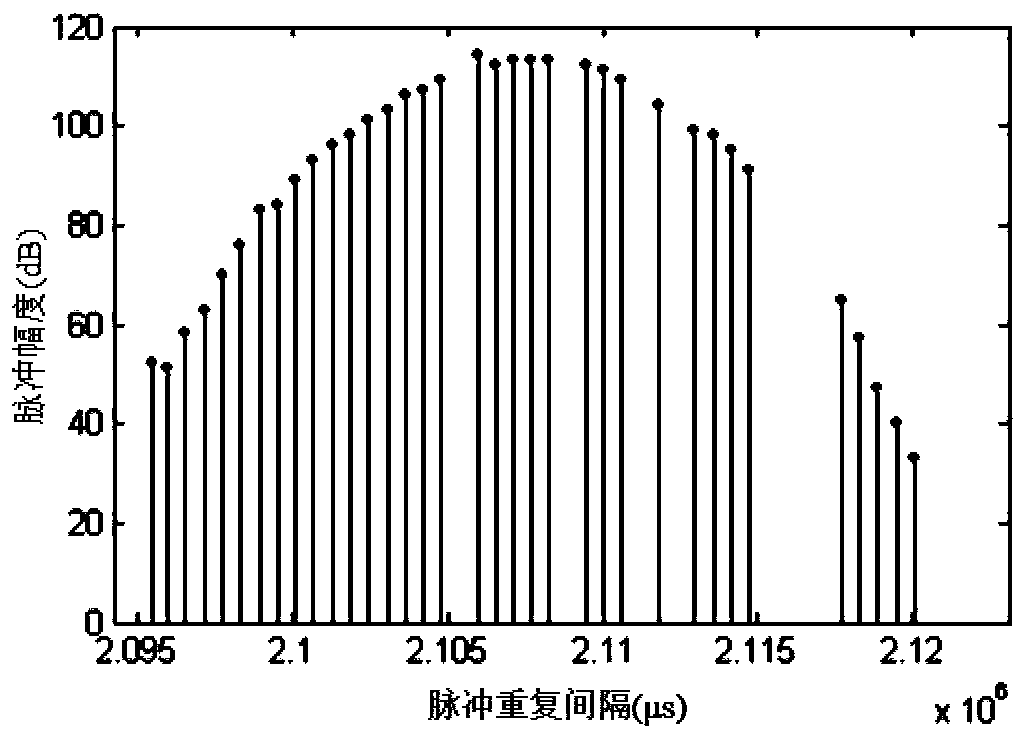Envelope extraction algorithm for signal pulse amplitude sorting
A signal pulse and envelope extraction technology, applied in the field of radar signals, can solve the problems of inability to sort pulse groups, staggered signals, unknown sorting effect, and poor sorting effect.
- Summary
- Abstract
- Description
- Claims
- Application Information
AI Technical Summary
Problems solved by technology
Method used
Image
Examples
example 1
[0095] Example 1: Including aliasing signal sorting experiment and analysis
[0096] The processing object in this section is the radar data set 1, and its original amplitude map is as follows Figure 5 shown. The number of original pulses in this section of the signal is 95, including 3 sets of radar sequences.
[0097] Because there are too many false pulses in the original pulse sequence, which affects the final effect of sorting, it is necessary to screen out the false pulses in the original sequence. This step mainly eliminates the environmental noise mentioned above. Table 2 is the number of pulses after pre-screening, Figure 6 This is the aliased signal amplitude plot obtained after pre-screening. The pre-screened radar pulse sequence can be approximately regarded as containing aliasing signal sequence. According to the actual data, the PRI type of radar 1 and radar 3 is dithering, and the PRI type of radar 2 is fixed.
[0098] Table 2 Pulse distribution table of...
example 2
[0105] Example 2: Signal sorting experiment and analysis of multiple aliasing methods
[0106] The processing object of this section is the radar data set 2, and its original amplitude map is as follows Figure 9 shown. The number of original pulses in this section of the signal is 174, including 4 sets of radar sequences.
[0107] The process of pre-screening is the same as Section 4.1, Table 4 shows the number of pulses after pre-screening, Figure 10 This is the aliased signal amplitude plot obtained after pre-screening. The pre-screened radar pulse sequence can be approximately regarded as containing aliasing signal sequence. According to the actual data, the PRI type of radar 1 is pulse group, the PRI type of radar 2 is jitter, and the PRI type of radar 3 and radar 4 is fixed.
[0108] Table 4. Pulse number distribution table of radar data set 2 after pre-screening
[0109]
[0110] After pre-screening, the radar data set 2 is sorted, and the final result of this ...
PUM
 Login to View More
Login to View More Abstract
Description
Claims
Application Information
 Login to View More
Login to View More - R&D
- Intellectual Property
- Life Sciences
- Materials
- Tech Scout
- Unparalleled Data Quality
- Higher Quality Content
- 60% Fewer Hallucinations
Browse by: Latest US Patents, China's latest patents, Technical Efficacy Thesaurus, Application Domain, Technology Topic, Popular Technical Reports.
© 2025 PatSnap. All rights reserved.Legal|Privacy policy|Modern Slavery Act Transparency Statement|Sitemap|About US| Contact US: help@patsnap.com



